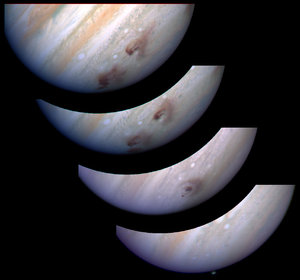

Shoemaker-Levy 9 impact site G
This mosaic of WFPC-2 images shows the evolution of the G impact site on Jupiter (the 21 comet fragments of Shoemaker-Levy 9 were each assigned a corresponding letter to identify the impact site; G represents the 7th fragment to strike the planet. It was also the largest impact.).
The images from lower right to upper left show: the impact plume at 07/18/94 07:38 UT (about 5 minutes after the impact); the fresh impact site at 07/18/94 at 09:19 UT (1.5 hours after impact); the impact site after evolution by the winds of Jupiter (left), along with the L impact (right), taken on 07/21/94 at 06:22 UT (3 days after the G impact and 1.3 days after the L impact); and further evolution of the G and L sites due to winds and an additional impact (S) in the G vicinity, taken on 07/23/94 at 08:08 UT (5 days after the G impact).
Over 15 years later, ESA's Herschel space observatory has linked water in Jupiter's upper atmosphere to the impact of comet Shoemaker-Levy 9.





